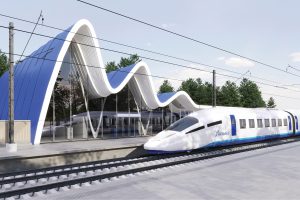LTG Infra, the company responsible for the implementation of the Rail Baltica project in Lithuania, has signed contracts with the winner of two tenders. One is for planning the infrastructure of the Panevėžys railway node, and the other is for preparing the documents necessary for the design of regional stations and engineering systems in the Rail Baltica section from Kaunas to the Lithuanian-Latvian border. Both tenders, announced last December, were awarded to Kelprojektas and Kelvista.
“Once the special plan for the Panevėžys railway node is completed, it will become clear where the new international Panevėžys passenger station will be built. Meanwhile, the special plan for regional stations will determine the need for regional connections and exact locations. It is planned that there will be at least five regional stations in the section from Kaunas to the Lithuanian-Latvian border. Connecting the main Rail Baltica railway line with the regions will certainly provide added value to smaller cities,” says Director of Rail Baltica Coordination at LTG Infra Arenijus Jackus
 Under one tender, services for the engineering infrastructure development plan and environmental impact assessment (EIA) for transport communications of the railway infrastructure of the Panevėžys railway node of Rail Baltica will be procured. The service delivery term is 24 months, and the price excluding VAT amounts to EUR 950 thousand.
Under one tender, services for the engineering infrastructure development plan and environmental impact assessment (EIA) for transport communications of the railway infrastructure of the Panevėžys railway node of Rail Baltica will be procured. The service delivery term is 24 months, and the price excluding VAT amounts to EUR 950 thousand.
According to the other tender, the service provider will have two years to prepare the development plan for the engineering infrastructure and the engineering systems of transport communications of regional stations of the Rail Baltica railway line between Kaunas and the Lithuanian-Latvian border. The value of this tender is almost EUR 740 thousand excluding VAT.
As part of its contractual obligations, the successful tenderer will have to assess the current situation, provide general and specified solutions, prepare alternatives to the development of Rail Baltica, identify specific land taken for public needs, as well as assess the environmental impact of the planned infrastructure.
Rail Baltica is a greenfield rail transport infrastructure project with the goal to integrate the Baltic States in the European rail network. 870 km of the high-speed double-track electrified railway with 249 km/h speed trains is to cross Lithuania, Latvia, and Estonia. The width of the new railway line will be 1,435 mm, its route will include Tallinn-Pärnu-Riga-Panevėžys-Kaunas-the Lithuanian-Polish border and the connection Kaunas-Vilnius.
